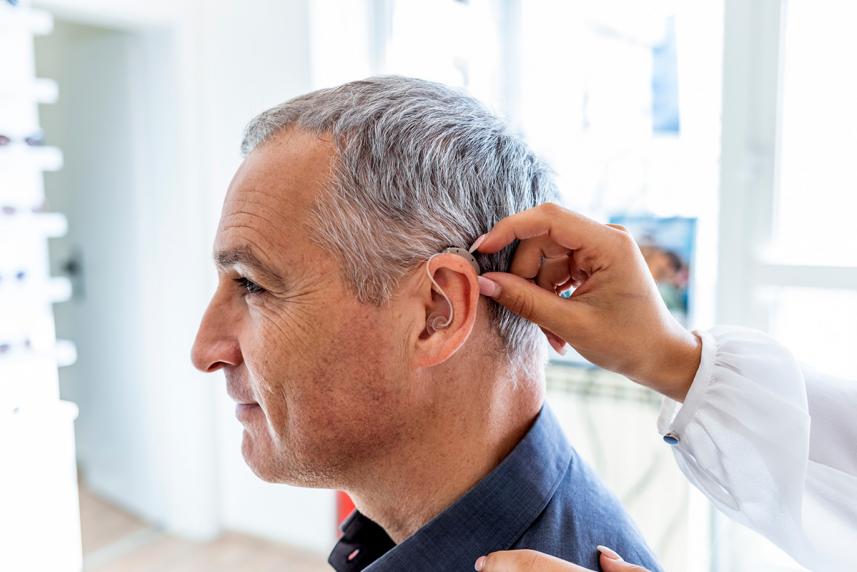
Changes in hearing can be subtle at first. Find out if hearing loss may be interfering with your life.
These devices come with a range of features. Here are some options to explore at your hearing appointment.

Buying prescription hearing aids can feel like choosing a new smartphone. Like smartphones, these devices also come with high-tech features designed to make your life easier.
So, you may feel a bit overwhelmed at your hearing appointment as you consider all the choices. Is Bluetooth necessary? Should you try hearing aids that fit inside the ear or behind it?
Luckily, there’s help. Doing some research beforehand gives you an idea of the features you might want to ask about. Then your hearing care professional will help you explore your options. Hearing care professionals, including audiologists, hearing aid dispensers and hearing instrument specialists, specialize in treating hearing loss.1 If you belong to AARP®, you can request a no-cost hearing exam and consultation through AARP® Hearing Solutions™ provided by UnitedHealthcare Hearing.
“The goal is to help a patient find the one that matches the lifestyle they want to have, and to hear as well as they should,” says Rachel Sours. She’s a hearing instrument specialist at Willoughby Hearing Aid centers in North Plains, Oregon.
So, whether this is your first pair of hearing aids or you’re upgrading to new ones, here are some questions to consider.

Changes in hearing can be subtle at first. Find out if hearing loss may be interfering with your life.
Bluetooth is a wireless technology that lets you connect your hearing aid to your phone via an app. The app also allows you to control some of the hearing aid’s features, such as adjusting the volume or background noise.2
That’s not all Bluetooth can do though. It can also connect to your laptop, TV or any other device that is Bluetooth enabled. That means you can stream audio from the device directly into your hearing aids. This includes your favorite show, your workout playlist or a phone call.2
Bluetooth is common in today’s hearing aids. Don’t worry if you’re a Bluetooth newbie. Your hearing care professional can show you how to use it.
“A lot of people are afraid of Bluetooth, and think, “Oh, I’m not tech savvy, I don’t think I can learn this,’” says Sours. “We’re trained to help them learn it.” They can walk you through the features, such as hands-free phone calls, that may help you the most. And they can turn off confusing or stressful tools that you don’t want to use.
But you’re in control. If tech isn’t your thing, you don’t have to connect to the hearing aid’s app. Besides, Bluetooth isn’t essential for the hearing aid to work, Sours explains. The hearing aid will still create great sound without it.
Background noise can make it hard to hear a conversation, whether you’re at work or your favorite lunch place. All hearing aids come with noise reduction, or a way to lower background noise. But the amount varies depending on the model.3
If you’re a social butterfly or work in a noisy setting, you’ll want to pay special attention to the noise reduction features in any of the models you’re thinking about buying, says Sours.
For example, almost all pairs come with digital noise reduction technology. This type of tech reduces background noise while increasing the sound of someone’s voice. That way, you can hear what they’re saying more clearly.4
Some models have features that let you adjust sounds via an app. So, if you’re in a noisy restaurant and need to hear the waiter, you can do that on your phone.2 And the newest models use artificial intelligence (AI) to automatically adjust sounds.4 This reduces the chance that you’ll need to ask people what they just said.
There are 3 main styles of hearing aids, according to the National Institute on Deafness and Other Communication Disorders:5
So, which one is right for you? It depends on several factors, says Sours. These include:
Fit matters, especially for active folks. “If someone goes to the gym or jogs on the beach, they want to know that their hearing aid will stay in their ear,” says Sours.
After all, everyone’s ears are a slightly different shape. And not all designs will suit your ears. Your hearing care professional will help you pick a pair that feels secure and comfortable in or around your ear.
If you’re a member of AARP Hearing Solutions, you get up to 3 follow-up visits at no extra cost — and a trial period to try out your new prescription hearing aids. Learn more.
All hearing aids come with batteries. They’re either rechargeable or disposable (small button batteries). Disposable batteries, which need to be replaced often, aren’t that common anymore, according to the Cleveland Clinic.6
Rechargeable batteries have become popular for many reasons. For one thing, they’re more convenient.7 You just pop your hearing aids in a charging dock at night. In the morning, you’re good to go. “They’re also helpful for people who don’t have the hand dexterity or eyesight to change tiny batteries on their own,” says Sours. And they are eco-friendly, since there are no used batteries to throw away.
One benefit of disposable batteries? You can replace the batteries anywhere, and they don’t require a power source.
Every so often, or annually, a hearing care professional will have to adjust your hearing aids. Some hearing aids allow them to do that remotely, via an app, notes Sours. This is especially helpful if you have a health condition or mobility issue that makes it tough to make it to in-person appointments.
What’s most important is finding the hearing aids that fit your hearing and physical needs, as well as your habits and lifestyle. You might not need all the features mentioned here, but it’s great to have options.
See a hearing care professional to discuss the features that are must-haves for you. They’ll walk you through your choices so you can start to hear better again.
Sources
Information is for educational purposes only and is not a substitute for the advice of a licensed medical provider. Consult your provider prior to making changes to your lifestyle or health care routine.
AARP Hearing Solutions is available to all AARP members and does not require a health insurance plan from UnitedHealthcare. The AARP hearing program discount cannot be combined with any other discounts, promotions, coupons or hearing aid benefit plans unless noted herein. Products or services that are reimbursable by federal programs including Medicare and Medicaid are not available on a discounted or complimentary basis. AARP commercial member benefits are provided by third parties, not by AARP or its affiliates. Providers pay a royalty fee to AARP for the use of its intellectual property. These fees are used for the general purposes of AARP. Some provider offers are subject to change and may have restrictions. Please contact the provider directly for details. UnitedHealthcare Hearing is provided through UnitedHealthcare, offered to existing members of certain products underwritten or provided by UnitedHealthcare Insurance Company or its affiliates to provide specific hearing aid discounts. This is not an insurance nor managed care product, and fees or charges for services in excess of those defined in program materials are the member’s responsibility. UnitedHealthcare does not endorse nor guarantee hearing aid products/services available through the hearing program. This program may not be available in all states or for all group sizes. Components subject to change.
Hearing aids purchased in the Silver technology level will receive 1 follow-up visit.